Alessia Locatelli: Discipula is composed by three people: MFG Paltrinieri, Mirko Smerdel and Tommaso Tanini. What is your background and where did you first meet?
We met at the end of the 90s in Florence within the punk hardcore scene. Together we started the band To the Ansaphone, with which we recorded albums and played in Italy and abroad. This experience ended in 2004 when we decided to focus on our studies: visual art and curatorial practices for Mirko, photography for Tommaso and cultural sociology for Marco.
A: Discipula in latin means Disciple. Of which teachers?
The name Discipula hasn’t got any special connotation or deep meaning. It is just a word that belongs to our past as a band (it was part of the title of a song) and for us is simply a way to connect two experiences distant from each other in time but nonetheless very connected. Nonetheless, there is a certain mystery and ambiguity about it we didn’t think about when we picked it and that we really like.
This said, when referring to our artistic education we can state that we are not coming from any specific “school” and we haven’t had any master that strongly affected our work under the name of Discipula. For sure, there are people that influenced us on a more personal level and with whom we still like to confront ourselves. One example is Francesco Jodice. Mirko’s teacher at Naba and a good friend of us today.
Finally, expanding this question towards our inspirations and influences, well, things get a bit more complicated. Our work is informed by a variety of different movements, languages and practices. To bring on the table just a few examples: the historical vanguards and conceptual art, the political sci-fi of movie directors such as John Carpenter and George A. Romero and writers like J.G. Ballard e Phillip K. Dick; the research in radical architecture and design carried on by Archizoom, Superstudio, Haus-Rucker-Co, Ugo la Pietra e Gianni Pettena; the dialogue between visual art and electronic music explored in the 70s by Throbbing Gristle, up to the work full of contaminations of more contemporary artists such as Liam Gillick, Slavs & Tatars, David Maljkovic, Metahaven e Hito Steyerl…
The history of images has always been strongly connected to political control. Just to provide you with an example: in 1916 the President of the United States T. W. Wilson created a Governative Commission for Propaganda, known also as “Creel Commission”, whose goal was to influence the American public opinion in favour of an intervention of the US Army during the first World War.
At the end of the 90s the main opinion was that ideologies were dead. I think that, today, your work not only suggests a re- reading of such a claim but it goes even further. On your website you say that: “Images invade and expand our world and the perception we have of it and (…) they become gateways to the ideology that creates them”. Don’t you think you might sound anachronistic to talk about ideologies today, in the time where grand narratives seem long gone?
First of all, we believe that the word ideology doesn’t carry any negative connotation per se. We also think that it is not possible to escape from an ideological reading of reality. This said, we believe that from the 80s, with the rise of capitalism, traditional ideologies such as social and cultural movements, have been increasingly subtracted to people and communities to a point in which capitalism itself appeared to be “the only possible model”. Such ideology is so pervasive and omnipresent today that we are not able to see its contours anymore. By quoting George Monbiot: “Imagine if the people of Soviet Union would have never heard of communism. The ideology dominating our lives hasn’t got, for the majority of us, any name.”
What we are trying to do with Discipula is an attempt to bring back into sight the contours of the macro ideology within which we live today. By doing this, we believe, it might be possible to imagine something outside of it, an alternative. We do this mainly through the research and the work on images because we believe that images represent the main means through which the dominant power projects an idealised reality capable to hide that big void which is today, the present time. In an article recently appeared on e-flux, Armgard Emmelhainz says that the era in which we are currently living “implies not a new image of the world, but the transformation of the world into images”
A: Let’s speak now about your modus operandi. Discipula operates by appropriating the language and the communication techniques (advertisement, 3D renderings, stock images) that belong to a consumerist society. Your goal is to give form to new and unexpected significations, capable to create a pristine interpretative space.
Referring to this, I would like you to tell us more about your “outdoor” project, in which you occupied huge billboards present in several areas of Milan with slogans aimed at making people think through the advertisement medium.
What do you think is the best way today to use such strategies in order to invite people to think about the current state of things?
To what concern our modus operandi in general, we could say that each of our projects represents some sort of lab in which images captured from the flow of production and consumption are dissected, reprogrammed and put into dialogue with other images or languages (texts, sounds) in order to trigger and observe transformation in their signification. Our works could be perceived in this sense as little “ecologies” in which the public is invited to explore the complex and ambiguous nature of visual language.
With regard to “Outdoor Media Action”, it is a bit special for us because for the first time we move out of our “lab” and we work directly in the field. The work is part of “How Things Dream”, an ongoing project that imagines and explores the consequences of today’s growing relationship between technology, neoliberalism and new forms of control as seen through brand identity and communication strategies of an imaginary tech corporate: AURA. By adopting and retooling the language and mechanisms of advertising, How Things Dream envisions a transnational corporation, AURA, whose power permeates all aspects of everyday life. Through IoT applications and the analysis of BIG DATA as a source of information on patterns of human behaviour, AURA in fact provides essential services in areas such as healthcare, security and education.
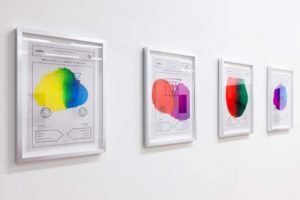
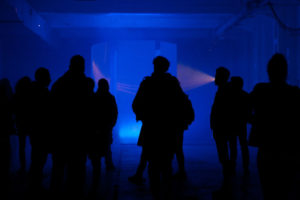
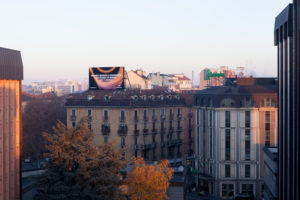
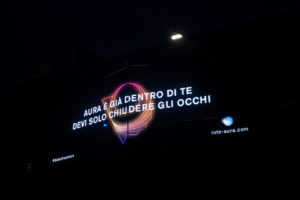
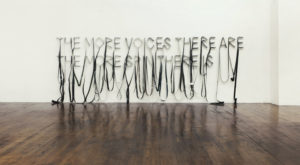
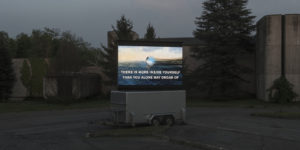
Through Aura’s advertisements we give life to a post-democratic and corporate-centred world; one in which surveillance and control are fully accepted and integrated in the commodification of daily life. The advertisements that appeared on the big LED screens in Milan refer to this specific universe and present the dystopian messages of AURA placed somewhere between the political and the spiritual.
To have the opportunities to use devices such as the LED screens (kindly offered to us by M4 Studio) gave us not only the possibility to reach far more people that we could ever reach during one of our exhibitions but also to reach them within the realm of everyday life, in which people minds operate in a completely different way compared to when, for instance, they are visiting a museum.
A: What other king of “actions” and projects are you working on to develop your vision of “engaged” artists?
It might sounds like a paradox if compared to what said so far, but we are struggling a bit with the idea of being labelled as “engaged” artists. It is also true to say that there are no direct political messages clearly emerging from our practice.
In fact, we prefer to operate by creating scenarios and situations in which the public is free to move and make up autonomously its own conclusions. With this regard, we are more interested in understanding and making visible the mechanisms through which images operate rather than, for instance, explicitly denounce their persuasive power. We think that such denounce would in fact put at risk a deeper process of exploration and ultimately of comprehension. So let’s state that we are focused on images rather than on activism.
A: Conceptually speaking, at the basis of your work there is an interesting nearness to the idea of Liquid Society proposed by Zygmunt Bauman but recontextualised in terms of liquid and trans-national power, through the contribution of the philosopher Slavoj Zizel and the sociologist Ulrich Beck. What do you think is the best way to put together within a single project/message the complexity of contemporary critique with the need to reach people?
To reply to this question it is necessary to begin from a broader reflection on the sector in which we operate, that is, the one of contemporary art: a self referential industry ruled by the market. Within this realm, ideas and concepts behind a work are very often neutralised and reduced to pure surface, to an object to withdraw from the world and hide in some collector’s house. So, the questions we pose ourselves are: how to survive within this system being able at the same time to share our research with as many people as possible? On the one hand, to have the possibility to create more situations like the one we generated with “Outdoor Media Action” can help. On the other, we could refer to our decision of develop different activities under the name of Discipula. Next to the artistic research, we in fact design and publish books independently, we organise workshops in collaboration with public institutions and we do lectures and talks. We believe that such variety is essential not only to find the best ways to use concepts and ideas but also to reach and connect as many different people as possible.
A: For many artists today the image lives in a state of continuous vilification, maybe even more than language. In fact, it is victim, on the one hand, of the mass production of advertisement images, full of stereotypes and, on the other, of the rise of visual illiteracy that feeds itself through people’s desire and urge to appear. How do you think it is possible, in such a scenario, to create works truly capable to intellectually stimulate your public?
By analizing the current conditions of visibility and, more in the general, the state of contemporary images, we can understand the importance for artists to tackle and explore more in depth the vilification you are talking about. One example for all is the great work of Hito Steyerl, both as visual artist and theoretician.
As we already said, our contribution to this cause consists in trying to show to the public the mechanisms behind the purely visual surface of the images. We do this through strategies that we have developed project after project: appropriation, manipulation, the dialogue (or the conflict at times) between different languages, the combination of reality and fiction, the analysis and use of different narrative strategies. Very often, when speaking about our work, we mention John Carpenter’s “They Live” in which the main character thanks to special glasses is able to see an alien species which control the world through subliminal message embedded into media and advertisement. We see these glasses as the perfect metaphor for the artist that through his/her practice reveals the reality in which we are immersed under a new perspective, showing this way problems and critical issues.
A: A few years ago, Alfredo Jaar with his work “Cold Storage” brought to the attention of the public the dangerous loss of historical photographic memory by leaving it in the hands of private organisations, that is, Corbis/Bill Gates. We are talking about more than 80 milions of images and archival material made inaccessible and hidden inside a huge storage in the States. What do you think about archives and about their management and preservation?
Up until today it has been a responsibility of the State to preserve the memory. In more recent years though we are observing a new and concerning phenomenon: the collection and archiving of data, both personal and public, by private corporations. In other words we are talking about the ownership of collective memory.
In our opinion this is a point as important as other issues related to for instance, the monitoring and re-selling of personal data for commercial purposes. It goes without saying that what these corporations are doing with our data must be to take into account and tackled but even more astonishing is the fact that private entities have the power to preserve our collective memories and therefore re-write history.
In other words, if up until today the State – in a more or less democratic way – was taking care of the history of its territory and people, in the future this duty might be taken over by corporations.
Memory (not only the photographic one) thanks to technology is becoming pretty much liquid, something we cannot control anymore. In this scenario, to know how to read images and the messages they are carrying, is probably not enough anymore, we also need to learn how to defend the public and universal value of the images and data carrying our memories, both public and collective.
A: How do you perceive intellectual property? Is it inevitable or can you imagine a system that doesn’t contemplate it.
We believe that everything has a cultural value must be shared and we support open source and creative commons. Unfortunately, it seems that today society is taking another direction. What is happening is a dystopian phenomenon which represents exactly the opposite of the Marxist socialist utopia: socialism imagined the abolition of bourgeoise property in defence of collectivity with the goal to guarantee same opportunities and dignity for everyone: a job, a house, education, healthcare.
Neoliberalism somehow foresees the abolition of the welfare state and of individual “micro-properties” to defend the monopoly of multinational corporate properties. All of this in the name of a general idea of a technology capable to manage, only apparently, society in a “neutral” way. Through a perverse mechanism that gives us the impression to gain freedom, independence and participation, we are slowly loosing everything. We won’t own a house anymore (maybe Airbnb will take care of it…), we won’t own money anymore (watch out for Bitcoins) we won’t own not only photographic albums but also hard disks anymore because our memories are getting stored on clouds and so on… This will lead to a full monitoring and capitalisation of our own lives.
A: As an art critic and curator I firmly believe that art today should adopt strategies to bring people back to the idea of visual culture in the broadest sense. Even better, it should be a tool for the reactivation of critical thinking. Young artists are probably capable to better understand and use the same technologies that are invading and influencing us today. So, in your opinion, is there a generational gap that is spontaneously emerging?
We are not too sure about it. For sure, new generations of artists born in the “age of the internet” have a sensibility and spontaneous ability to use today’s communication tools that place themselves at the heart of the “discourse” which is entirely of their own. The risk, though, is to be swollen by the “liquidity” of the same comunicative models they are also criticising.
Perhaps, those who experienced and worked in a pre internet world, and that therefore experienced the dramatic acceleration and transformations of the world since then, might have a more lucid approach that could influence the strength of their artistic statements. An example that pops into our mind is the work of Alfredo Jaar. Anyway, we think it is a matter of points of view and historical contextualisation. As far as we are concerned, we are happy to have seen and lived a world before the explosion of the internet and have grown as artists after.
A: Do you think it is impossible – or maybe useless – today to be original?
We believe that this is, all in all, a relative issue. To be original is hard but it should not be neither an obsession nor a goal per se. Rather, it should be the progressive outcome of a research process aimed at establishing a certain degree of confidence in the use of the tools and languages you decide to work with. Originality as a synonym of identity.
Regarding Discipula, we are probably more interested in playing with references rather than originality itself. We work trying to connect a variety of often very different ideas and resources and observing the outcomes. This approach sometimes pays back and sometimes doesn’t. For sure in this creative process there is a playfulness that is not only very stimulating but also necessary for our artistic growth.
A: What is the value of aesthetic in your works?
For sure aesthetic is very important. It represents not only the first impact but also the gate to our world and the means through which we comunicate our ideas.
A: Interventions of great scale, big advertisement spaces around Milan. How did you financially manage this kind of production?
All the examples you are providing refer to one single project “Outdoor Media Action”, which was made possible only thanks to the great support and understanding of the M4 Studio, that gave us the possibility to use the LED screens they manage around Milan and of Simone Sacchi who made possible the whole operation. At the moment we are developing our work in two parallel directions: one of public art focused on more relational and performative aspects and another centred on the more traditional production of artworks – with the support of MLZ Art Dep gallery – necessary to leave traces of our work, to document it and, last but not least, to financially support it through sales.
A: Aura is one of your last ongoing projects; at your presentation at Base last November it felt like attending to the birth of an imaginary tech corporate that provides essential services in areas such as domotics, healthcare, security, education and governance. By quoting your definition: “ A post-democratic world characterised by the final imposition of a corporate-centred global regime; one in which surveillance and control are fully accepted and integrated in the commodification of daily life”. Would you like to tell us more about Aura, especially in relation to your performance at Base at the end of last year? How does Aura fit within your “How Things Dream” project?
AURA is the main “character” of “How Things Dream”, a project that, as we said before, we are developing throughout two different approaches: one more traditionally related to the production of artworks, characterised by exhibitions in galleries and institutions, and another one in which we are mingling with the “outer world” started one year ago by placing Aura advertisings inside art magazines. It is within the latter approach that both “Outdoor Media Action” and “Endorsement”, the event at Base you mentioned above, can be located.
Regarding “Endorsement”, it is a multimedia live project conceived and realised together with the electronic musician Nicola Ratti. The collaboration with Nicola has started very spontaneously, following the interest and curiosity for each other work, and we hope it will grow further in the future. “Endorsement” imagines and presents the invasion of Aura within a subculture such as the one of experimental music. We are specifically talking about invasion because, here we imagine and represent Aura as a sponsor so invasive to literally interfere with the performance itself through adverts and by pushing the artist behind a branded monolith.
A: Finally can you please tell us where to follow you to know more about you and your upcoming events and the galleries you are working with in Italy?
You can find us on the usual places, Facebook (@discipuladiscipula) and Instagram (@discipula_collective) as well as on our website www.discipula.com. At the moment in Italy we are mainly working with MLZ Art Dep, Trieste gallery.
Alessia Locatelli

Alessia Locatelli was born in Milan in 1977. She collaborated with Denis Curti in the design of past editions of SiFest and the Canon Award, specializing in photography and becoming Indipendent Curator in organizing exhibitions with both public and private realities in Italy and abroad, while in parallel the curating and consulting activity continues for artists and photographers. She signs texts in some art magazines and in the Dossier Photography (third edition) within the “CAM, catalog of modern art” published by Editoriale Giorgio Mondadori-Cairo Group. Since 2016 she organizes and teaches professional courses to become Photocurator in some schools of photography (IIF, IED) and in other independent realities. She participates as Folio Reviewer in various Italian Photo Festivals (SiFest in Savignano, Photolux in Lucca, Fotografia Europea in Reggio Emilia). She is in charge of helping and assisting the authors in the selection of Fine Art cards and in the assembly materials useful for the conservation and sale to collectors. She collaborates in Italy with the German paper mill Hahnemühle. She is artistic director of the Enrico Cattaneo archive.




NO COMMENT